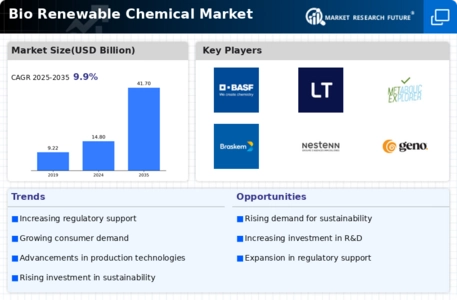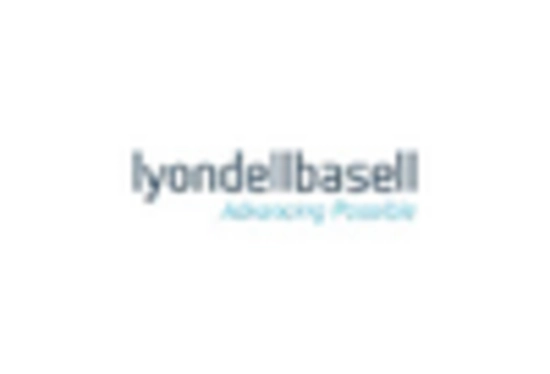Regulatory Incentives and Support
The Bio Renewable Chemical Market benefits significantly from regulatory incentives and support provided by various governments. Policies aimed at reducing carbon emissions and promoting renewable energy sources are creating a favorable environment for bio-renewable chemicals. For instance, many countries have implemented tax credits, subsidies, and grants to encourage the production and use of bio-based chemicals. This regulatory framework not only stimulates investment in the sector but also enhances the market's growth potential. According to recent data, regions with robust policy support have seen a 20% increase in bio-renewable chemical production capacity. As governments continue to prioritize sustainability, the Bio Renewable Chemical Market is likely to expand further, attracting new players and fostering innovation.
Increasing Environmental Awareness
The Bio Renewable Chemical Market is experiencing a surge in demand driven by heightened environmental awareness among consumers and businesses. As individuals become more conscious of their ecological footprint, there is a growing preference for sustainable alternatives to traditional petrochemical products. This shift is reflected in market data, indicating that the demand for bio-based chemicals is projected to grow at a compound annual growth rate of approximately 12% over the next five years. Companies are increasingly adopting bio-renewable chemicals to align with consumer preferences and corporate sustainability goals, thereby enhancing their market competitiveness. Furthermore, this trend is likely to encourage innovation in the sector, as firms seek to develop new bio-based products that meet the evolving expectations of environmentally conscious consumers.
Rising Demand from End-Use Industries
The Bio Renewable Chemical Market is experiencing increased demand from various end-use industries, including automotive, packaging, and personal care. These sectors are increasingly seeking sustainable alternatives to conventional chemicals, driven by consumer preferences and regulatory pressures. For example, the automotive industry is exploring bio-based materials for manufacturing components, while the packaging sector is shifting towards biodegradable options. Market data suggests that the demand for bio-renewable chemicals in these industries is expected to grow by approximately 15% annually over the next few years. This trend indicates a robust market potential for bio-renewable chemicals, as industries strive to meet sustainability targets and enhance their environmental credentials.
Investment in Research and Development
Investment in research and development is a crucial driver for the Bio Renewable Chemical Market. Companies are increasingly allocating resources to innovate and develop new bio-based products that meet the demands of a changing market landscape. This focus on R&D is essential for improving production processes, enhancing product performance, and expanding the range of applications for bio-renewable chemicals. Recent reports indicate that R&D spending in the bio-renewable sector has increased by over 25% in the past few years, reflecting the industry's commitment to innovation. As companies continue to invest in R&D, the Bio Renewable Chemical Market is likely to see a proliferation of new products and technologies, further solidifying its position in the broader chemical market.
Technological Advancements in Production Processes
Technological advancements are playing a pivotal role in shaping the Bio Renewable Chemical Market. Innovations in production processes, such as fermentation technology and enzymatic catalysis, are enhancing the efficiency and cost-effectiveness of bio-renewable chemical production. These advancements not only lower production costs but also improve the quality and variety of bio-based chemicals available in the market. Recent studies indicate that the adoption of advanced technologies could reduce production costs by up to 30%, making bio-renewable chemicals more competitive with traditional petrochemicals. As technology continues to evolve, the Bio Renewable Chemical Market is expected to witness an influx of new products and applications, further driving market growth.

















Leave a Comment